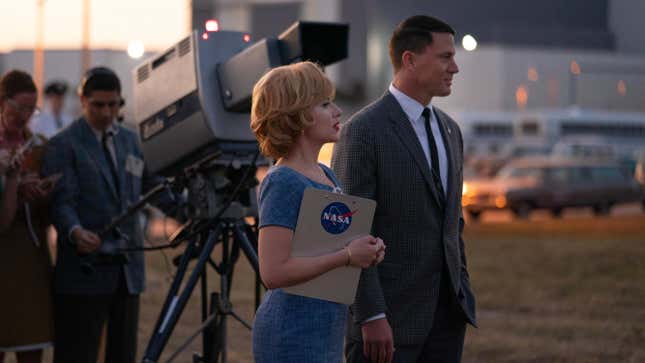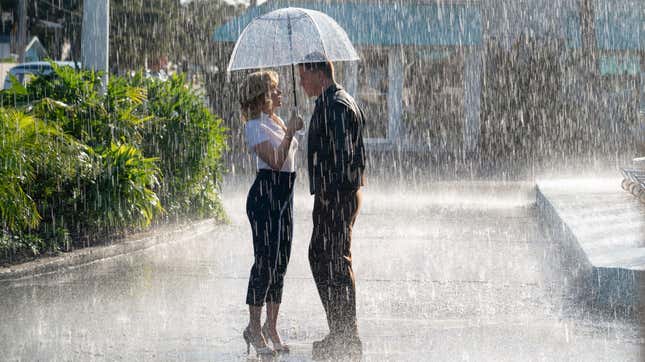
Fly Me To The Moon is being sold as a romantic comedy about a couple who fall for each other while working on a contingency plan to fake the moon landing for NASA in 1969. That does sound like a fun and interesting film. Unfortunately, that’s not what this film is. Those who might have been intrigued by the ad campaign may be surprised to learn that the moon-faking business doesn’t even come up until about halfway through. The first half of director Greg Berlanti’s film is devoted to Kelly Jones (Scarlett Johansson), a marketing guru with a shady past, doing the job she’s hired to do: “sell the moon” to the American public. Ironically, this bait-and-switch campaign is exactly the kind of thing she might have come up with to sell this film to the American public.
There are elements of both romance and comedy in Fly Me To The Moon, to be sure. Kelly and Cole Davis (Channing Tatum), flight director at NASA, are a typically mismatched couple. He’s a thick-necked straight shooter; she’s a gifted spin artist. Their meet-cute in a Florida diner comes before they know they’ll be working together, naturally, and involves literal flames and some awkward flirting. From there, they follow a standard path of mutual irritation to begrudging respect to genuine feelings to a serious setback to eventual reconciliation. Much of their love story relies on rom-com logic, which requires the audience to ignore how the real world works in order for it to make any sense. Unless you can put aside everything you know about the space program, government, advertising, and television broadcasting, you may spend a good deal of the film’s two-hour runtime frustrated by its plot holes and contrivances.
There’s no lack of chemistry between Johansson and Tatum, but there is a curious lack of sexiness, considering both actors have proven they’re more than capable of heating up a screen. Their banter often feels one-sided, less like a tennis match than a solo racquetball game, with Johansson doing most of the work. She nails the rhythm of an old-timey screwball heroine, but Tatum never quite meets her at her level. To be fair, Cole’s supposed to be a charm-free stick in the mud—he’s so lacking in charisma that she tries to hire an actor to play him in interviews—but at some point we need to see through that if we’re going to understand what Kelly sees in him. There’s a potentially affecting thread that has him feeling responsible for the real-life Apollo 1 disaster and the deaths of its three crew members, but it’s ultimately mishandled and ultimately undermined.
It all contributes to the problem of the film being set in 1969 as seen through the lens of 2024, with Cole representing the enterprising spirit of America and Kelly the opportunistic capitalist who views everything in terms of buying and selling. It’s an enticing (if not a completely historically accurate) parallel. The film’s plot hinges on NASA’s need for a PR campaign to boost interest in the Apollo mission. Tasked with this project, Kelly comes up with the idea to tie in products like Tang, Omega watches, Hasselblad cameras, and even Fruit of the Loom underwear in order to sell the space program. In reality, of course, it was the other way around. Space was hugely popular in the U.S. throughout the 1960s, and it was the companies who took advantage of that popularity by tying themselves to NASA and its astronauts. There were some noisy detractors, as Fly Me To The Moon constantly reminds us, but by and large the public was still on NASA’s side at this point. We also see Kelly glad-handing a few politicians who are wavering on a spending bill (the details and timing of this vote are left vague), which feels very modern, but is at least somewhat rooted in the politics of the era.

For those hoping to enjoy some lush mid-century details in the fashions and décor, the production design is believable, if not fully transportive. Johansson sports some effortlessly chic ‘60s looks nearly ruined by a series of terrible wigs. Tatum is often dressed to stand out as a jock among nerds, often in colorful, tight-fitting mock turtlenecks or polos against a sea of white dress shirts and dark ties. And yet he’s still upstaged by the strong supporting cast, particularly Ray Romano as NASA engineer Henry Smalls, Jim Rash as director Lance Vespertine, and Woody Harrelson as Moe Berkus (real name unknown), the shadowy government operative who hires Kelly to revamp NASA’s image. The film picks up momentum whenever they’re on screen. It’s a shame it doesn’t happen more often.
Like Kelly, Rose Gilroy’s script is constantly adapting and reinventing itself as it goes. The tone is all over the place. One minute it’s sincere and reverent, the next it’s deeply cynical. Some scenes are light and goofy, others are clearly meant to be inspiring. It’s hard to settle into any one version of this film with the ground constantly shifting beneath you. Berlanti is a guru in the world of television (his previous directorial effort is the half-hearted soap Love, Simon), where there’s more room to explore different styles and tones within a series that may run multiple seasons. Features are much less forgiving of such variations; here, it feels like the filmmakers lacked enough confidence in the material to maintain internal consistency.
There are moments in Fly Me To The Moon when you can almost see the movie it could have been, the one the trailers seem to be advertising. Those flashes of brilliance only last for so long, though, before the movie shifts into something else, and then something else again. To get so close only to miss the mark is almost more frustrating than if it were a failure through and through, like a rocket launch whose math is off just enough to thwart a lunar landing.